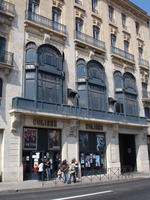You are in: Europe -> France -> Historic Fortified C... , and traditional search or Image Gallery will yield results of this site only
Historic Fortified City of Carcassonne
| Site number: | 345 |
|
| Type of site: | Cultural | |
| Date: | medieval | |
| Date of Inscription: | 1997 | |
| Location: | Europe, France, Languedoc-Roussillon Region, Département of the Aude | |
Up to 75 images are shown here. Click on each for more details or on Image Gallery for more images.
Six official UN languages:
Arabic,
Chinese,
English,
French,
Russian,
Spanish
Other languages: Breton, Bulgarian, Catalan, Czech, Danish, Dutch, Esperanto, Estonian, Finnish, German, Indonesian, Italian, Japanese, Norwegian-bokmål, Norwegian-nynorsk, Occitan, Polish, Portuguese, Serbian, Slovenian, Swedish
Other languages: Breton, Bulgarian, Catalan, Czech, Danish, Dutch, Esperanto, Estonian, Finnish, German, Indonesian, Italian, Japanese, Norwegian-bokmål, Norwegian-nynorsk, Occitan, Polish, Portuguese, Serbian, Slovenian, Swedish
| Description: | A fortified settlement has stood on Carcassonne’s hill ever since the pre-Roman period. In its present state the site exceptionally demonstrates a medieval fortified town, still consisting of its fine Gothic cathedral, massive defenses surrounding the castle and encircling buildings, and streets. Carcassonne did see a significant, though lengthy restoration campaign led by Viollet-le-Duc, one of the creators of the modern science of conservation. --WHMNet paraphrase from the description at WHC Site, where additional information is available. | |
| Carcassonne (Carcassona in Occitan) is a fortified French town, in the Aude département of which it is the préfecture, in the former province of Languedoc. It is separated into the fortified Cité de Carcassonne and the more expansive lower city, the ville basse. The folk etymology – involving a châtelaine named Carcas, a ruse ending a siege and the joyous ringing of bells ("Carcas sona") – though memorialized in a neo-Gothic sculpture of Mme Carcas on a column near the Narbonne Gate—is of modern invention. The fortress, which was thoroughly restored from 1853 by the theorist and architect Eugène Viollet-le-Duc, was added to the UNESCO list of World Heritage Sites in 1997. First signs of settlement in the region have been dated to about 3500 BC, but the hill site of Carsac—a Celtic place-name that has been retained at other sites in the south—became an important trading place in the 6th century BC. The Volcae Tectosages fortified the oppidum. Carcassonne became strategically identified when Romans fortified the hilltop around 100 BC and eventually made it the colonia of Julia Carsaco, later Carcasum (the process of swapping consonant is a metathesis). The main part of the lower courses of the northern ramparts dates from Gallo-Roman times. In 462 the Romans officially ceded Septimania to the Visigothic king Theodoric II who had held Carcassonne since 453; he built more fortifications at Carcassonne, which was a frontier post on the northern marches: traces of them still stand. Theodoric is thought to have begun the predecessor of the basilica that is now dedicated to Saint Nazaire. In 508 the Visigoths successfully foiled attacks of the Frankish king Clovis. Saracens from Barcelona took Carcassonne in 725, but King Pippin the Younger drove them away in 759. --Wikipedia. Text is available under the Creative Commons Attribution-ShareAlike License. | ||
| Source: | http://whc.unesco.org/en/list/345 | |
| Reference: | 1. UNESCO World Heritage Center, Site Page. | |
























































